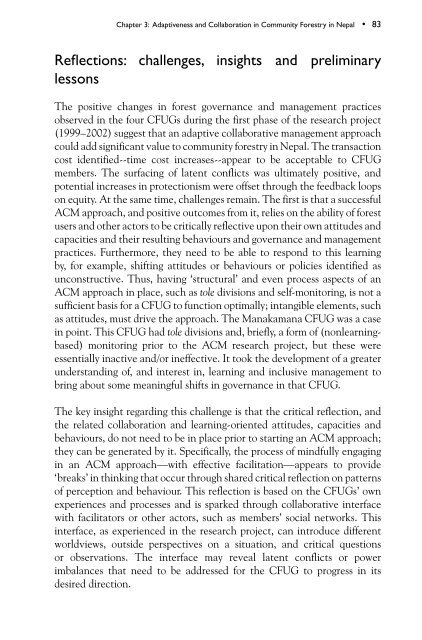Adaptive collaborative management of community forests in Asia ...
Adaptive collaborative management of community forests in Asia ...
Adaptive collaborative management of community forests in Asia ...
Create successful ePaper yourself
Turn your PDF publications into a flip-book with our unique Google optimized e-Paper software.
Chapter 3: <strong>Adaptive</strong>ness and Collaboration <strong>in</strong> Community Forestry <strong>in</strong> Nepal • 83<br />
Reflections: challenges, <strong>in</strong>sights and prelim<strong>in</strong>ary<br />
lessons<br />
The positive changes <strong>in</strong> forest governance and <strong>management</strong> practices<br />
observed <strong>in</strong> the four CFUGs dur<strong>in</strong>g the first phase <strong>of</strong> the research project<br />
(1999–2002) suggest that an adaptive <strong>collaborative</strong> <strong>management</strong> approach<br />
could add significant value to <strong>community</strong> forestry <strong>in</strong> Nepal. The transaction<br />
cost identified--time cost <strong>in</strong>creases--appear to be acceptable to CFUG<br />
members. The surfac<strong>in</strong>g <strong>of</strong> latent conflicts was ultimately positive, and<br />
potential <strong>in</strong>creases <strong>in</strong> protectionism were <strong>of</strong>fset through the feedback loops<br />
on equity. At the same time, challenges rema<strong>in</strong>. The first is that a successful<br />
ACM approach, and positive outcomes from it, relies on the ability <strong>of</strong> forest<br />
users and other actors to be critically reflective upon their own attitudes and<br />
capacities and their result<strong>in</strong>g behaviours and governance and <strong>management</strong><br />
practices. Furthermore, they need to be able to respond to this learn<strong>in</strong>g<br />
by, for example, shift<strong>in</strong>g attitudes or behaviours or policies identified as<br />
unconstructive. Thus, hav<strong>in</strong>g ‘structural’ and even process aspects <strong>of</strong> an<br />
ACM approach <strong>in</strong> place, such as tole divisions and self-monitor<strong>in</strong>g, is not a<br />
sufficient basis for a CFUG to function optimally; <strong>in</strong>tangible elements, such<br />
as attitudes, must drive the approach. The Manakamana CFUG was a case<br />
<strong>in</strong> po<strong>in</strong>t. This CFUG had tole divisions and, briefly, a form <strong>of</strong> (nonlearn<strong>in</strong>gbased)<br />
monitor<strong>in</strong>g prior to the ACM research project, but these were<br />
essentially <strong>in</strong>active and/or <strong>in</strong>effective. It took the development <strong>of</strong> a greater<br />
understand<strong>in</strong>g <strong>of</strong>, and <strong>in</strong>terest <strong>in</strong>, learn<strong>in</strong>g and <strong>in</strong>clusive <strong>management</strong> to<br />
br<strong>in</strong>g about some mean<strong>in</strong>gful shifts <strong>in</strong> governance <strong>in</strong> that CFUG.<br />
The key <strong>in</strong>sight regard<strong>in</strong>g this challenge is that the critical reflection, and<br />
the related collaboration and learn<strong>in</strong>g-oriented attitudes, capacities and<br />
behaviours, do not need to be <strong>in</strong> place prior to start<strong>in</strong>g an ACM approach;<br />
they can be generated by it. Specifically, the process <strong>of</strong> m<strong>in</strong>dfully engag<strong>in</strong>g<br />
<strong>in</strong> an ACM approach—with effective facilitation—appears to provide<br />
‘breaks’ <strong>in</strong> th<strong>in</strong>k<strong>in</strong>g that occur through shared critical reflection on patterns<br />
<strong>of</strong> perception and behaviour. This reflection is based on the CFUGs’ own<br />
experiences and processes and is sparked through <strong>collaborative</strong> <strong>in</strong>terface<br />
with facilitators or other actors, such as members’ social networks. This<br />
<strong>in</strong>terface, as experienced <strong>in</strong> the research project, can <strong>in</strong>troduce different<br />
worldviews, outside perspectives on a situation, and critical questions<br />
or observations. The <strong>in</strong>terface may reveal latent conflicts or power<br />
imbalances that need to be addressed for the CFUG to progress <strong>in</strong> its<br />
desired direction.
















